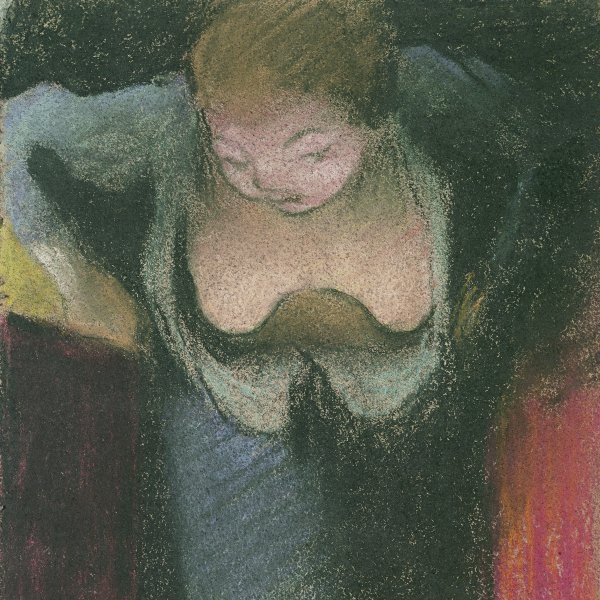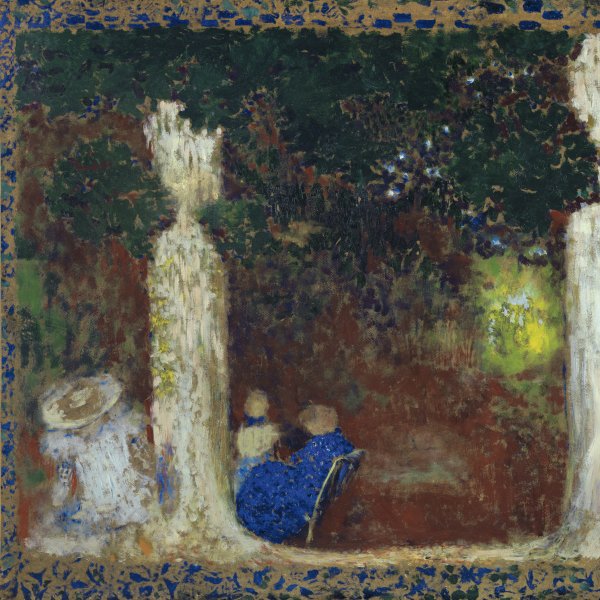Édouard Vuillard
Cuiseaux, 1868-Le Baule, 1940
From his youth the French painter Édouard Vuillard had been friends with Ker-Xavier Roussel, Maurice Denis, Pierre Bonnard and Paul Sérusier, who became his colleagues of the group known as Les Nabis in 1889. Together with them he pursued a new Synthetist art inspired by the example of Paul Gauguin, in which direct observation of nature was less important and the reduction of forms and colours was taken to an extreme.
After discontinuing his family’s military tradition in 1885 and attending the Académie Julian, in 1888 Vuillard was admitted to the École des Beaux-Arts. However, he soon shunned the rigidity of the academic school and teamed up with Bonnard and Sérusier, two of the most prominent representatives of the Nabis. Through his friendship with Aurélien Lugné-Poë, a theatre producer who introduced Symbolist drama to Paris, he enjoyed an intense relationship with the world of the theatre and was involved in founding the Théâtre de L’Oeuvre. He collaborated in the staging of several works, such as Maeterlinck’s L’Intruse and Les Aveugles, and Alfred Jarry’s Ubu roi. The Nabis’ association with La Revue Blanche during the 1890s enabled him to contribute to the review as an illustrator. His friendship with its editors, the Natanson brothers, brought him his first commissions for series of decorative panels.
When the century turned Vuillard’s style tended towards greater naturalism. He came into contact with the Hessel family and a close relationship sprang up between them. As a result the Hessels’ circle of friends became the new clientele for his landscapes and, in particular, his portraits, which eventually would form the predominant genre in his painting. He portrayed the sitters in domestic, indoor settings, capturing the fashions and ways of life of the haute bourgeoisie of the period.
At the end of his life Vuillard received important public commissions to produce large mural paintings, such as in the Palais Chaillot in 1936 and the Geneva headquarters of the League of Nations in 1937.He died in 1940 following the German invasion; two years after the Musée des Arts Décoratifs staged a retrospective of his oeuvre.
After discontinuing his family’s military tradition in 1885 and attending the Académie Julian, in 1888 Vuillard was admitted to the École des Beaux-Arts. However, he soon shunned the rigidity of the academic school and teamed up with Bonnard and Sérusier, two of the most prominent representatives of the Nabis. Through his friendship with Aurélien Lugné-Poë, a theatre producer who introduced Symbolist drama to Paris, he enjoyed an intense relationship with the world of the theatre and was involved in founding the Théâtre de L’Oeuvre. He collaborated in the staging of several works, such as Maeterlinck’s L’Intruse and Les Aveugles, and Alfred Jarry’s Ubu roi. The Nabis’ association with La Revue Blanche during the 1890s enabled him to contribute to the review as an illustrator. His friendship with its editors, the Natanson brothers, brought him his first commissions for series of decorative panels.
When the century turned Vuillard’s style tended towards greater naturalism. He came into contact with the Hessel family and a close relationship sprang up between them. As a result the Hessels’ circle of friends became the new clientele for his landscapes and, in particular, his portraits, which eventually would form the predominant genre in his painting. He portrayed the sitters in domestic, indoor settings, capturing the fashions and ways of life of the haute bourgeoisie of the period.
At the end of his life Vuillard received important public commissions to produce large mural paintings, such as in the Palais Chaillot in 1936 and the Geneva headquarters of the League of Nations in 1937.He died in 1940 following the German invasion; two years after the Musée des Arts Décoratifs staged a retrospective of his oeuvre.






